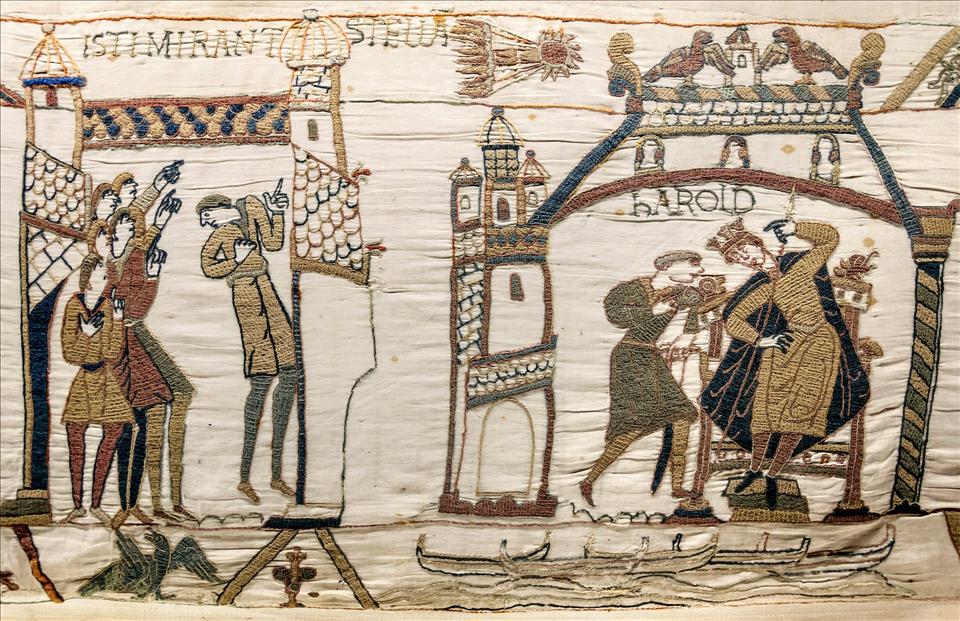
How Medieval Chroniclers Interpreted Solar Eclipses And Other Celestial Events
Most medieval observation of the heavens was by eye. Chroniclers, if not observing the event themselves, would rely on an eyewitness or other written records for the details.
Technologies such as the astrolabe – an early instrument for mapping the stars – were common in medieval Europe from the 12th century, and known much earlier in the Islamicate regions (influenced by Islamic civilisation). While Europe's early celestial chroniclers also used astronomical models translated into Latin from Greek and Arabic, they had no telescopes and none of the other technology people have access to today.
Gervase lived in a world where nature was believed to be closely connected to human activity. The ancient and medieval universe placed the Earth at the centre of the universe , with a series of spheres surrounding it, split into two zones.
Below the Moon, these spheres were of the elements: earth and water, air, fire. Above the Moon came the spheres of the planets: Mercury, Venus, the Sun, Mars, Jupiter, Saturn, and then the stars, fixed into their constellations.
Medieval scholars saw the solar system as based on concentric circles. Science History Images/Alamy
In the context of a universe of spheres, ancient and medieval thinkers all worked on the principle that what is above affects that which is below. It is important to appreciate that this explains the serious attention paid to astrology in ancient and medieval thought. Planets, they believed, had effects on the human world. Natural phenomena, in this way, were connected and integral to understanding that world.
Astronomy, and its associated discipline of astrology, had direct practical application in human activity at the time, from religious study of the calendar and events to medicine and agriculture. Astronomy's broad usefulness in working out timings for medical procedures or the weather was widely acknowledged. Philosopher and scientist Robert Grosseteste (c.1170-1253) explained this in his treatise On the Liberal Arts (c.1200):
Image of part of the Bayeux Tapestry. CC BY
According to Gervase, the purpose of writing a chronicle was to record the deeds of kings and princes, and the record of miracles and portents. Direct correlations were made then by chroniclers of the period between celestial phenomena and political change – bearing in mind that most, if not all, chronicles were written after the fact. The Melrose Chronicle , compiled in the 13th century, notes that:
A famous example is the appearance of Halley's comet in 1066, which was associated by contemporaries with the change of regime in England: from Harald Godwinson to William the Conqueror , who took control after the Battle of Hastings in 1066.
One of the striking things about Gervase is how precise his descriptions of natural phenomena were, especially those that seemed to him to pass understanding. One example is his account of what can now be identified as ball lightning .
Another example, from September 13 1178, concerns the observation of the“horns” of the partially eclipsed Sun rotating to point towards the Earth. Gervase states he was an eyewitness of this eclipse.
Viewers of the eclipse on April 8 2024 in San Diego , California, will be able to see something very similar to the observation Gervase described, with the Sun's horns rotating and pointing vertically downwards. Modelling helps us to predict that the view of the moon in San Diego is going to be very close to that seen by Gervase, because of the precise position and timing. Elsewhere in the US, the view of the eclipse will be slightly different.
A view of a partial eclipse were seen as the sun's 'horns' by medieval viewers. Mark Andrew Thomas/Alamy
Also in 1178, Gervase records in similar detail how the Moon's image was seen to split in two by witnesses who reported this to him. Our analysis suggests that this probably resulted from it being seen through a column of hot air . And Gervase was not alone in detailing this. English Benedictine monk Matthew Paris described a spectacular display of halos around the Sun in 1233:
Today's celestial spectaclesThese days, celestial spectacles are seen as simply manifestations of the richness of a natural world that is explicable, at least in principle.
Nevertheless, despite the predictive success of, for example, the theory of gravity and classical dynamics, there are still problems that remain unpredictable. Some can be deceptively simple – for example, the double pendulum or Rott's pendulum (a pair of pendulums which form a“chaotic” system, whose motion cannot be mathematically predicted).
Others include meteorological phenomena and weather forecasting – and here, in many ways, we find ourselves in a similar position to medieval chroniclers.
In long-term weather forecasting, for instance, we can observe, but we are still unable to predict precise future outcomes such as extreme weather with accuracy. The medieval chroniclers saw wonders in the heavens as portents. It might serve us well to re-learn why, and to draw our own perspectives on the inter-connections of things.

Legal Disclaimer:
MENAFN provides the information “as is” without warranty of any kind. We do not accept any responsibility or liability for the accuracy, content, images, videos, licenses, completeness, legality, or reliability of the information contained in this article. If you have any complaints or copyright issues related to this article, kindly contact the provider above.






















Comments
No comment